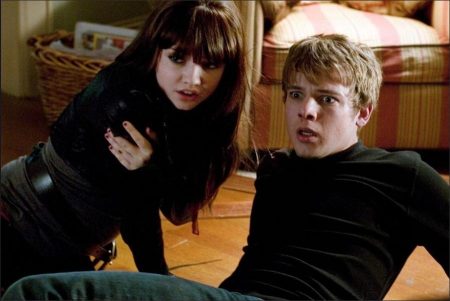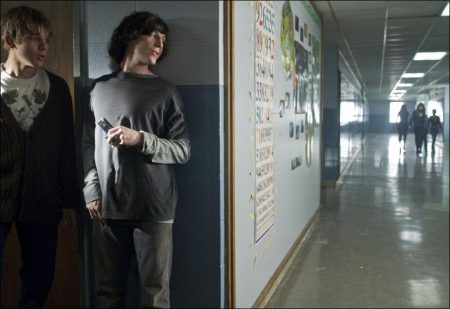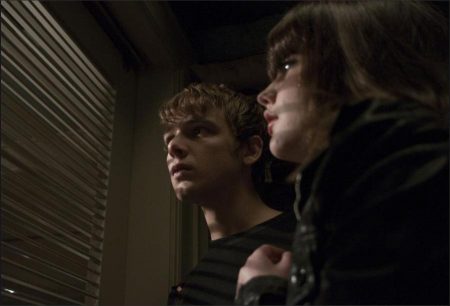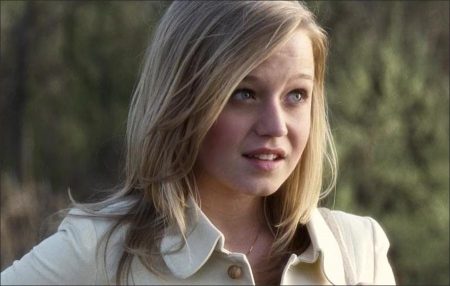Taglines: Only one has the power to save their souls.
Why? Legend has it that this man had seven personalities… and only one was a killer. The others cried out for help, and in the melee that followed his last series of attacks, the police shot the killer. All seven personalities supposedly died on the spot. But now, the Ripper personality wants his revenge. It was just a ghost story to amuse the town’s kids… until, on the sixteenth birthday of the Riverton Seven, an unknown assailant begins to murder them, one by one.
Has the psychopath been reincarnated as one of the Riverton Seven, or did he survive the night he was plunged into the river after a fiery ambulance crash? His body was never found, so the town’s police believe that’s the logical explanation. But is it the right one? It’s up to one boy to find the answer… before he and the rest of the Riverton Seven are dead.
Adam “Bug” Hellerman (Max Thieriot, Jumper) was one of the children born the bloody night the Ripper vanished. A simple, achingly innocent boy, he’s grown up hearing the stories about the killer and has been plagued by nightmares since he was a baby. But this unlikely hero finds himself chosen to save his friends from the monster that’s returned in flesh or in spirit.
Now, he must face an evil he knows won’t rest… until it wrecks the vengeance it pledged the day Bug was born. How Bug accomplishes this makes for a coming-of-age story with edge, humor and pure terror in equal degrees… and a wild and gripping ride from beginning to end.
My Soul to Take (originally called 25/8) is an American supernatural horror film, written and directed by Wes Craven. It is his first film since 1994’s Wes Craven’s New Nightmare that he both wrote and directed. The film stars Max Thieriot as the protagonist Adam “Bug” Hellerman, who is one of seven teenagers chosen to die. The film was unsuccessful at the box office, and has a 9% approval rating at Rotten Tomatoes. The film’s title comes from a line in the prayer “Now I Lay Me Down to Sleep”, which reads “If I shall die before I wake, I pray the Lord my soul to take.” The prayer features in the film.
About the Production
Fear Ye the Ripper: My Soul to Take Begins
“My name is Adam Hellerman, but everyone calls me Bug. I live in Riverton, Massachusetts, a small town notable for fishing, tourism… and the Riverton Ripper.” — Bug
Wes Craven returns to his roots with the shocking suspense thriller My Soul to Take. For the film, he imagined a tale of unimaginable tragedy and disturbing violence that kept him awake at night. Still, he admits he was excited to fully conceive and helm a project again. “I hadn’t realized it had been that long since I had written and directed something,” he reflects. “I had directed Red Eye and other films by very talented writers, but it wasn’t personal quite the way that this is.”
Reflecting upon his inspiration for the Riverton Ripper, the evil who terrorizes the small town in My Soul to Take, Craven offers that it was the story that chose him. He wondered what would happen if an average man who was living a humdrum existence happened upon the weapon of a serial killer who was terrorizing the region. When he realizes that the knife actually belongs to him, he starts putting together the pieces of the puzzle…and is devastated by what he finds.
For the tale, Craven dreamed up a serial killer who had multiple personalities—one a family man, another a twisted psychopath. The main character was someone whose body was shared by the kind and gentle Abel Plenkov…as well as the vicious Riverton Ripper. Craven explains: “I thought, ‘Wow! Everything is going great for this guy, then…what if ?’ Suddenly, he’s having these echoes of ‘Oh my God, did I do something?’ I thought how horrible that would be, particularly if that man had been living an exemplary life before he switched.”
The writer/director fleshed out what would happen if these personalities spilled out of the murderer and into others after a brutal night when he was shot and killed. This inspired the idea for the birth of seven babies born the night Abel/the Ripper died. “I thought it would be interesting to follow these kids and tell their stories through the eyes of Bug, the central character,” Craven says.
He knew it would be challenging to juggle the manifestation of the killer’s personalities among the teenagers known as the Riverton Seven, rumored to share the soul of the Ripper. This resulted in a screenplay that is “much more complex than anything I had done before,” says Craven. “It was initially tough to keep all of these characters interacting so that it didn’t become just two stories—a kid at school and a kid with his family. I wanted to mesh all of the characters within a 24-hour span, and therein lay the challenge.”
When Craven’s wife, fellow producer Iya Labunka, read the script, she recognized he had created a sociopath as terrifying and creepy as his villains of the past. “Our greatest fears always come from our imagination,” Labunka reflects. “I felt that the story worked on so many different levels. It’s got thrills and chills and blood but it also has a lot of tension-relieving humor, which is what Wes is known for.”
My Soul to Take offers more of a psychological thriller than many of Craven’s other creations. When we first meet Abel, he’s living what appears to be a normal life, when suddenly, an evil personality appears that sends him completely out of control and after the very people that Abel loves the most.
“That’s what’s so terrifying about our villain,” offers Labunka. “He has a family he is obviously in love with, but he has no control over what happens. That destroys everyone and everything that is dear to him in a way he could never have anticipated or wanted. It’s frightening because it can happen to any one of us, and it can occur in a way that we have no control over.”
With much of the story told from his perspective, Bug’s quest is to discover if Abel was someone who was good but was taken over by a horrible affliction… or if he was a homicidal maniac who cleverly disguised his disease by pretending to be normal. Additionally, Bug must learn if the person responsible for the new killings is the Ripper returned, if one of his classmates is possessed by the Ripper’s soul… or even more terrifying: if the Ripper’s soul is inside Bug himself.
The core myth of My Soul to Take is best expressed by the Haitian-born EMT who witnessed the Ripper’s crimes all those years ago: Jeanne- Baptiste (played by The Visitor’s DANAI GURIRA). “The Haitian’s concept is not that a person has multiple personalities, it’s that a person has multiple souls,” explains Craven. “If that person should happen to die and is host to an evil personality, that’s not the end of it; rather, when a person dies, their soul—or in this case, souls—can live on. If the bad guy dies, it’s not necessarily over, as his soul can reappear in one of the Riverton Seven and they could be the next iteration of the brutal killer.”
Key to his story was a tale of internal transformation. Craven explains that concept as it’s expressed in Bug. He says, “This experience can be something quite beautiful, as death can be a shedding of an old persona and result in rebirth. At the film’s end, all Bug’s illusions are stripped away and he has to face everything that’s happened to the people of Riverton. Out of all these horrible things, he takes the best of what has been shattered and puts it in resolve. This is what I think we all do; we have to lose our illusions. We find out that many things are lies, and we take the best of what we can salvage.”
With Craven’s shooting script in place, it was time to cast the young characters who make up the Riverton Seven, as well as the supporting cast of players who live in this twisted world of the Ripper.
Continue Reading and View the Theatrical Trailer
My Soul to Take 3D (2010)
Directed by: Wes Craven
Starring: Nick Lashaway, Zena Grey, Max Thieriot, Denzel Whitaker, Dennis Boutsikaris, Emily Meade, Jessica Hecht, Paulina Olszynski, Frank Grillo, Elena Hurst, Shareeka Epps, Harris Yulin
Screenplay by: Wes Craven
Production Design by: Adam Stockhausen
Cinematography by: Petra Korner
Film Editing by: Peter McNulty
Costume Design by: Kurt and Bart
Set Decoration byB Carol Silverman
Art Direction by: Jack Ballance, Brianne Zulauf
Music by: Marco Beltrami
MPAA Rating: R for strong bloody violence, and pervasive language including sexual references.
Distributed by: Rogue Pictures
Release Date: October 29, 2010





